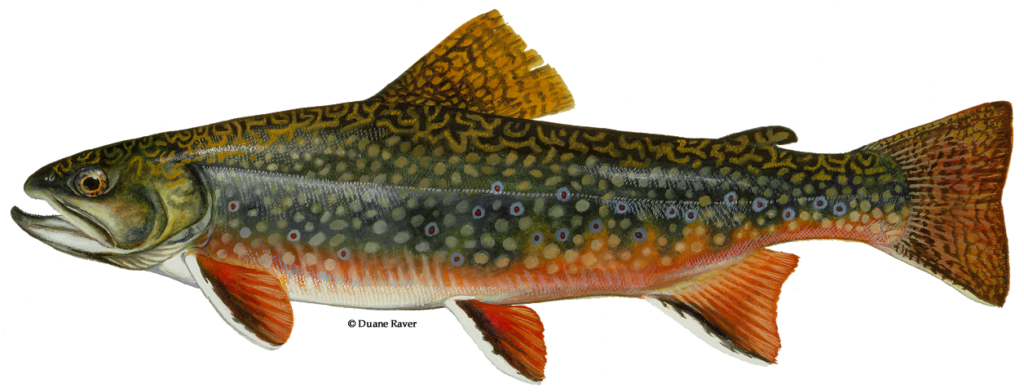
Brook trout probably entered the Henrys Fork of the Snake River system via introduction by early settlers. The brook trout quickly adapted to life in Henrys Lake and did quite well there.
The Fish
Brook trout are members of the char family of fish that evolved in cold, low productivity waters in the northern hemisphere and were originally found primarily in the Eastern Unites States. As the rail system developed, brook trout were introduced widely into Western waters. They are related to lake trout, bull trout, and dolly varden. Brook trout are very colorful fish with quite intricate markings that distinguish them from the other char. One characteristic that distinguishes them from lake trout is the worm like markings on the dorsal fin. Brook trout spawn in the autumn in a similar manner to the spring spawning cutthroat. They generally thrive in streams as well as lakes. Brook trout are prolific and often displace native species, such as cutthroat. Brook trout live to be 4 or 5 years old in Henrys Lake. A few survive to spawn as four-year-old fish however very few brook trout live beyond four years.

Brook Trout Fry & Fingerlings
Brook trout are planted in Henrys Lake in either June or September. The timing is dependent on space available at the rearing hatchery and environmental conditions. Dependent on rearing conditions, the June plants are normally fry sized (less than three inches) and the September plants are fingerlings or fish sized from three to six inches. Once in the lake, brook trout feed on plankton, tiny insects, aquatic worms and fragments of larger organic material. They grow fast and as they grow the preferred diet is for larger prey. Soon leeches, freshwater shrimp, damselflies, mayflies, midges and other small fish are important diet items. In Henrys Lake, brook trout tend to eat fish in higher proportions that the other Henrys Lake fish.
The Fishery
Henrys Lake brook trout are some of the largest brook trout in the Western United States. The Idaho state record brook trout came from Henrys Lake in 1978 and weighed over 7 pounds. These fish are prized by Henrys Lake anglers because of their superior fighting qualities, beautiful markings and coloration and their excellent taste. The fish has naturalized or adapted well to Henrys Lake, in spite of the harsh conditions there. The brookie in Henrys averages over 16 inches in the creel and can grow to over 24 inches and over 6 pounds. Like the hybrid trout at Henrys Lake, the Idaho Department of Fish and Game plants sterile brook trout in the lake. The brook trout population within Henrys Lake can be controlled with these sterile fish and the possibility of displacing native species by overpopulation is therefore eliminated. Anglers can still enjoy pursuit of this popular quarry, while protections for the native species remain intact. Stocking was halted between 1999 and 2003. Because of this, reduced catch rates were noted in the early part of this decade. However, catch rates for brook trout have now rebounded. Management objectives for the brook trout include catch rates of .10 fish per hour or 10 hours per fish. Stocking rate objectives are set at 100,000 per year to maintain this catch rate objective. As with all the fish species at Henrys, catch rates are driven by stocking rates. However, environmental factors can also influence fingerling survival and resulting catch rates. The Ashton hatchery rears the brook trout prior to liberation in Henrys Lake.
Resources: U.S. Fish & Wildlife Services
